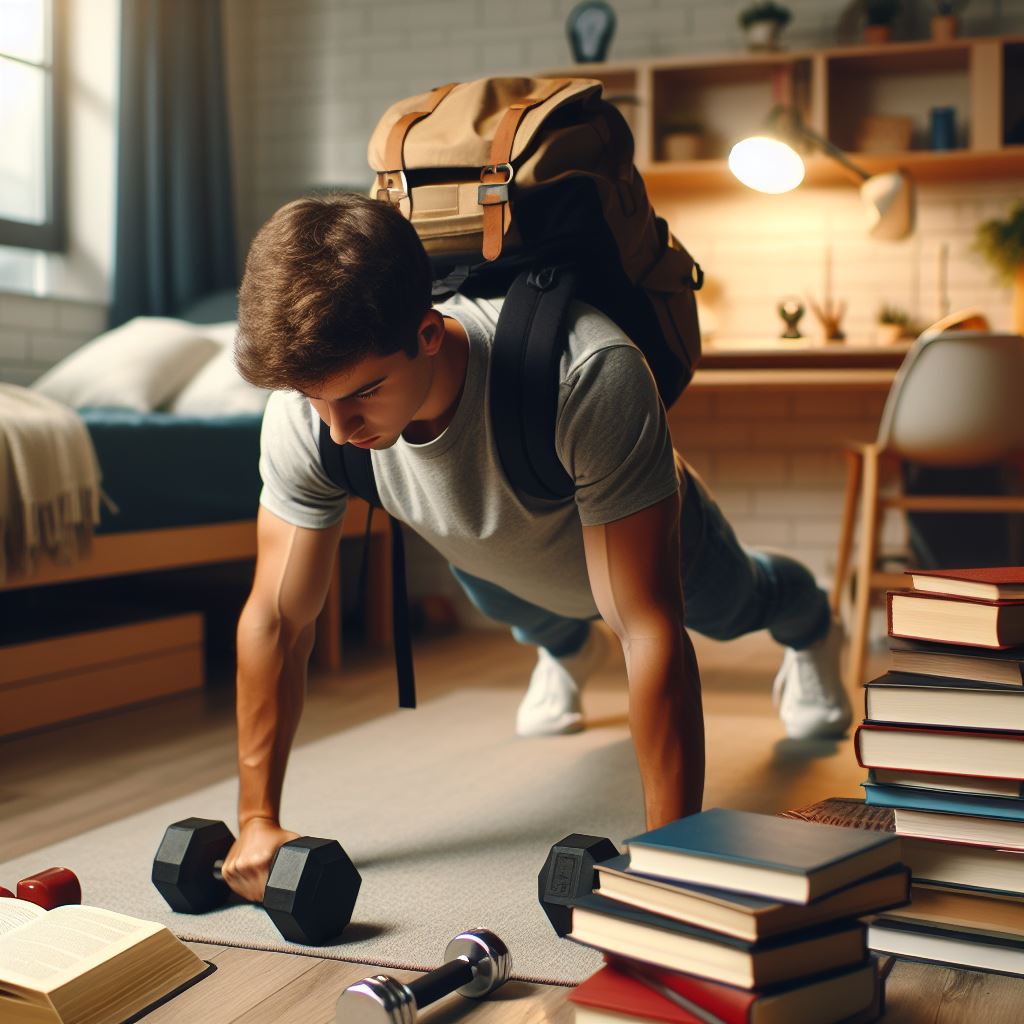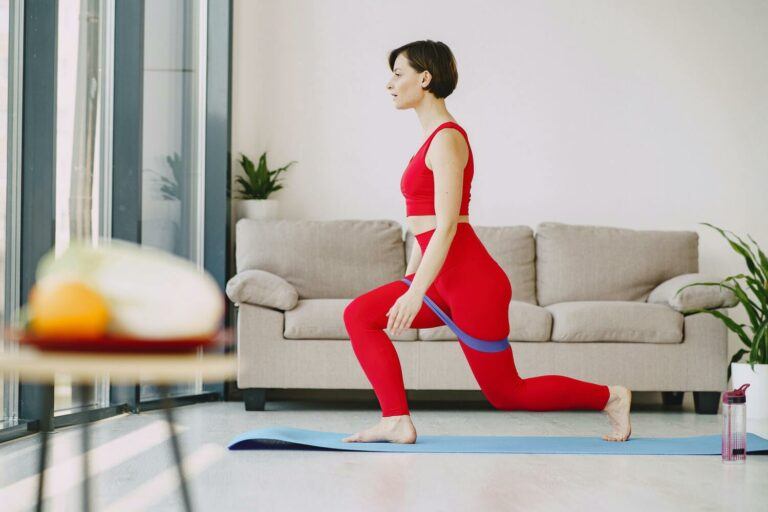College life is a whirlwind of classes, social events, and late-night study sessions.
Fitting in regular exercise can feel like an impossible feat.
But what if you could ditch the expensive gym membership and create a functional home gym without sacrificing precious time or blowing your budget?

This guide is here to show you exactly how!
The Perks of a Budget Home Gym:
- Convenience is King: No more trekking to the gym across campus, waiting for machines, or squeezing in workouts around crowded schedules. Your home gym is always open, ready for a quick sweat session whenever you have a spare 20 minutes.
- Save Big Bucks: Gym memberships can be a significant financial burden for students. Building your own home gym with budget-friendly equipment allows you to achieve your fitness goals while keeping money in your pocket.
- Privacy and Comfort: Avoid the intimidation or self-consciousness that can come with working out in a public gym. Blast your favorite workout playlist, wear your comfiest clothes, and get moving in the privacy of your own space.
Crafting Your College-Friendly Home Gym

Dorm rooms and apartments often come with limited square footage. Don’t worry! A functional home gym doesn’t require a dedicated room. Here are some tips for maximizing your space:
- Utilize Walls and Doors: Install a pull-up bar in a doorway or mount shelves on the wall to store equipment and free up floor space.
- Think Foldable and Adjustable: Opt for equipment that folds away easily or can be adjusted to target different muscle groups.
- Invest in Multifunctional Gear: Look for equipment that offers a variety of exercises, like dumbbells that can be used for squats, lunges, and upper body work.
Building Your Budget Arsenal

Forget fancy weight machines. Here’s a breakdown of essential equipment that won’t break the bank:
Bodyweight Exercises
These require no equipment and are a great way to build strength and endurance.
- Push-ups (modify on knees if needed)
- Squats
- Lunges
- Sit-ups/Crunches
- Planks
- Wall sits
Free Weights
Dumbbells are incredibly versatile and can be used for a full-body workout. Start light and gradually increase weight as you get stronger.
- A set of adjustable dumbbells is ideal, allowing you to modify the weight for different exercises (think squats vs. bicep curls).
- Look for used dumbbells online or at thrift stores for significant savings.
Resistance Bands
These inexpensive bands offer a wide range of resistance levels and can be used for strength training, stretching, and mobility exercises.
- Resistance bands come in various lengths and thicknesses, allowing you to target different muscle groups.
Cardio Options
Staying active keeps your heart healthy and improves overall fitness. Here are some budget-friendly cardio options for your home gym:
- Jumping rope: A classic for a reason! Inexpensive and provides a great cardio workout.
- High-intensity interval training (HIIT): Short bursts of intense activity followed by rest periods. No equipment needed, just your bodyweight and a timer on your phone.
- Online fitness classes: Many free or low-cost online fitness platforms offer cardio workouts like aerobics, dance fitness, or kickboxing routines.
Table: Sample Budget-Friendly Home Gym Equipment
| Equipment | Cost Range | Benefits |
|---|---|---|
| Pull-up Bar | $10-$30 | Upper body strength, back muscles, core |
| Adjustable Dumbbells (20-50 lbs) | $30-$80 | Full-body strength training, adjustable weight for various exercises |
| Resistance Bands | $10-$20 | Strength training, stretching, mobility, various resistance levels |
| Jumping Rope | $5-$10 | Cardio workout, inexpensive, portable |
| Exercise Mat | $10-$20 | Provides cushioning for floor exercises, comfortable stretching surface |
Remember: Prices may vary depending on brand, quality, and where you purchase the equipment.
Fueling Your Workouts
Nutrition plays a crucial role in achieving your fitness goals. Here are some tips for eating healthy on a student budget:
- Meal prep: Cook large batches of healthy meals on the weekends and portion them out for the week.
- Focus on whole foods: Prioritize fruits, vegetables, whole grains, and lean protein sources.
- Utilize student discounts: Many grocery stores offer student discounts on healthy staples.
Sample Budget Home Gym Workout Routine

This sample routine uses minimal equipment and can be completed in 30 minutes, perfect for a busy student schedule.
Perform each exercise for 30 seconds with 15 seconds rest in between.
Repeat the entire circuit 2-3 times, depending on your fitness level.
Strength Training Circuit (20 minutes):
Exercise 1: Squats (Bodyweight):
- Stand with feet shoulder-width apart, toes slightly outward.
- Engage your core and keep your back straight as you lower your body as if sitting in a chair.
- Descend until your thighs are parallel to the ground (or as low as comfortable) and press through your heels to stand back up.
Exercise 2: Push-ups (Modification on knees if needed):
- Start in a high plank position with hands shoulder-width apart, core engaged, and body in a straight line from head to heels.
- Lower your chest towards the ground, bending your elbows at a 90-degree angle.
- Keep your back straight and core engaged throughout the movement.
- Push back up to the starting position.
Exercise 3: Dumbbell Rows (if you have dumbbells):
- Stand with feet hip-width apart, knees slightly bent, and hold a dumbbell in each hand with palms facing inward.
- Keeping your back straight and core engaged, hinge at the hips and lower the dumbbells towards the ground.
- Squeeze your shoulder blades together at the bottom of the movement, then return to the starting position.
Modification: If you don’t have dumbbells, you can perform bodyweight rows using a sturdy table or chair.
Place your hands shoulder-width apart on the edge of the table or chair, step back with your feet, and lower your body towards the ground, keeping your back straight and core engaged.
Pull yourself back up to the starting position.
Exercise 4: Lunges (Bodyweight):
- Stand with feet hip-width apart.
- Take a large step forward with one leg, lowering your body until both knees are bent at 90-degree angles.
- Ensure your front knee tracks over your ankle and your back knee doesn’t touch the ground.
- Push through your front heel to return to the starting position and repeat with the other leg.
Modification: You can add a jump to your lunges for a more cardio-intensive exercise.
After pushing through your front heel to return to the starting position, jump explosively and switch legs in mid-air before landing in a lunge on the other side.
Exercise 5: Plank (Bodyweight):
- Start in a high plank position with hands shoulder-width apart, core engaged, and body in a straight line from head to heels.
- Hold this position for 30 seconds, focusing on maintaining a flat back and tight core.
Modification: If holding a high plank is too challenging, lower yourself down to your forearms so your elbows are bent at a 90-degree angle and your forearms are flat on the ground.
This is a low plank and still provides a great core workout.
Repeat the entire circuit 2-3 times, depending on your fitness level.
- Cool-down (5 minutes):
- Static stretches: Hold gentle stretches for each major muscle group for 15-30 seconds, focusing on your legs, back, chest, and shoulders.
Pro-Tips:
- Listen to your body: Don’t push yourself too hard, especially when starting. Take rest days when needed and gradually increase intensity as you get stronger.
- Proper Form: It’s more important to focus on proper form than using heavy weights. Incorrect form can lead to injury.
- Track your progress: Keep a workout log to track your progress and stay motivated.
- Make it fun: Put on some upbeat music, create a workout playlist, or find a workout buddy to keep things engaging.
Building Your Budget Home Gym Beyond the Basics
The sample routine above provides a solid foundation for your home gym workouts.
As you progress and get stronger, you might want to consider adding some variety and challenge to your routine.
Here are some tips for expanding your home gym without breaking the bank:
Invest in Gradual Upgrades:
- Adjustable Weights: Instead of buying multiple sets of dumbbells, opt for adjustable dumbbells that allow you to increase the weight as you get stronger.
- Weighted Items: Utilize household items! Fill a backpack with books for weighted squats or lunges. Use water jugs or canned goods as makeshift weights.
Explore Free Resources:
- Online Workouts: Many free YouTube channels and online fitness platforms offer a wide variety of workout routines targeting different muscle groups and fitness levels.
- Bodyweight Exercise Variations: Find variations of bodyweight exercises to target different muscle groups or increase difficulty. For example, try elevated push-ups with your feet on a chair or bench, or diamond push-ups for a more tricep-focused workout.
Embrace the Outdoors:
- Running/Jogging: No equipment needed! Take advantage of your campus green space or local park for an invigorating cardio session.
- Park Workouts: Many parks have outdoor fitness equipment that can be used for bodyweight exercises like pull-ups, dips, and leg raises.
Remember: Safety is paramount. Always listen to your body, use proper form to avoid injury, and don’t hesitate to modify exercises based on your fitness level.
FAQs
Q: I don’t have any equipment at all. Can I still get a good workout?
A: Absolutely! Bodyweight exercises are a fantastic way to build strength and endurance. The sample workout routine above uses only bodyweight exercises, and you can find many other free online resources for bodyweight workouts.
Q: How often should I work out?
A: Aim for at least 30 minutes of moderate-intensity exercise most days of the week. You can break this down into shorter workouts if that fits your schedule better. Don’t forget to schedule rest days for your body to recover.
Q: What should I eat after a workout?
A: Focus on replenishing your energy stores with a combination of protein and carbohydrates. A healthy snack like yogurt with fruit or a whole-wheat sandwich with lean protein is a good option.
The Takeaway

Creating a budget-friendly home gym doesn’t require fancy equipment or a dedicated space.
With a little creativity and resourcefulness, you can build a functional gym right in your dorm room or apartment.
By following these tips and incorporating the sample workout routine, you’re well on your way to achieving your fitness goals as a busy college student.
Remember, consistency is key!
So get moving, stay motivated, and enjoy the journey to a healthier you!
Related Posts



